|
|
Observing Highlights - Jul-Dec 2007Website archive 1995-2013 |
Victoria Centre is part of the national Royal Astronomical Society of Canada, which is dedicated to bringing information about astronomy to the general public. |
|
|
|
|
|
|
|
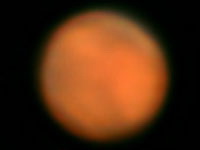 Mars
- Dec 20, 2007 10:40PM PST - Mars was making its closest pass to
earth until 2016. North is toward the lower left corner of the image. -
John McDonald Mars
- Dec 20, 2007 10:40PM PST - Mars was making its closest pass to
earth until 2016. North is toward the lower left corner of the image. -
John McDonald |
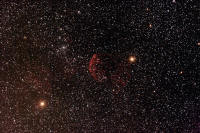 IC443
- November 29, 2007 IC443
- November 29, 2007I spent Thursday evening at Pearson College. Seeing conditions were as good as they get from that location. Mark Wheen hosted a viewing session for half a dozen Pearson students. An image of IC 443 located near Propus in Gemini. Also framed is the smaller nebula IC 444 and part of the larger and dimmer nebula Sh2-249.Constellation: Gemini. |
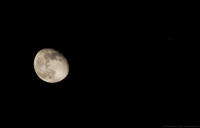 Moon
- Mars conjunction - Nov 26, 2007 11:00pm PST Moon
- Mars conjunction - Nov 26, 2007 11:00pm PSTIt was cloudy and snowing in the afternoon, but by 10:30pm the clouds parted and we experienced a beautiful clear sky, revealing this lovely conjunction of Mars with the Moon two days past full phase. The Moon and Mars are only 1.4� apart. |
| For a collection of images of Comet 17/P Holmes from our members, please visit Victoria Centre's Comet 17/P Holmes |
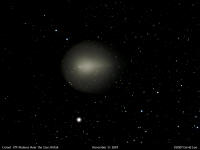 Comet 17-P Holmes Near the Star Mirfak
- Nov 21, 2007 Comet 17-P Holmes Near the Star Mirfak
- Nov 21, 2007It was another chilly night in Victoria but the skies were clear. A thin veil of cloud threatened to rise from the east but it stayed clear for my imaging session. The comet was now past Mirfak but still within the field of view of the NP101is. I've been imaging with the Fuji S2 ever since the image of the comet exceeded the chip size of the Meade DSI Pro. The comet was also noticeably dimmer. |
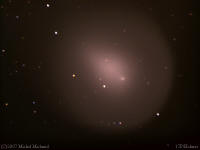 Comet
17P/Holmes - Nov 10, 2007 Comet
17P/Holmes - Nov 10, 2007Another shot of the comet 17P Holmes. The view is very nice with the large open cluster Alpha Persei in background. The size of the bubble had increase a lot compared with the picture taken on the November 6th. |
|
Last night I was out at
At first I could see the entire structure of the comet right out to the edge of the fainter outer halo. As the outer faint halo dimmed and disappeared so did a large amount of the glow that fills in the area within the first halo. What remained looked somewhat like a wagon wheel with the central hub being the stellar pseudo nucleus and the very bright fan shaped coma. As things continued to dim the outer ring began to thin moving towards its outer edge until it disappeared. At the same time the stellar pseudo nucleus dimmed and blurred until it merged into the glow of the central fan. The fan continued to hold in there for some time until it too disappeared. I looked up to see that the cloud cover was very dense. I was amazed at how well it had shone through the clouds. It was cool to see visually where the brightness densities of this comet are, without the need to do all sorts of manipulation in image editing software. (not that, that too isn't cool) As an aside, while that area was obscured, the Moon was clear so I swung the 25" over to it. I have a question. Are there 7 craterlets in Plato? : ) Also the crater Petavius with its central mountains and straight rima, looked like a Google Earth image of the Emerald City, with the Yellow Brick Road running into it. |
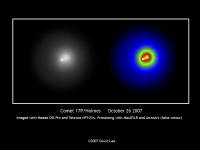 Comet
P17/Holmes - Oct 26, 2007 Comet
P17/Holmes - Oct 26, 2007Friday offered another opportunity to view Comet Holmes and to image it this time with the Meade DSI Pro. My hopes were to better define the structure of the comet head area. By now the gaseous halo had enlarged. With this set of images I was able to make the pseudo-nucleous more distinct along with its surrounding area. David Lee |
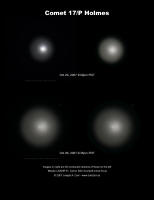 Comet
17/P Holmes 24 hour comparison - Oct 25/26, 2007 - I did a bit of
Sidewalk Astronomy last evening. Since I was visiting friends who happen to
live close to Observatory Hill, I took my telescope and photo gear with me
and setup in their driveway. Visually, I could see the comet's gas cloud had
grown considerably from last night's observations from Observatory Hill. My
friends were impressed with the comet, but asked if "that thing is going to
hit us". I assured them that was highly unlikely, but one of these years we
might get a meteor shower from some of the dust it is throwing off. Comet
17/P Holmes 24 hour comparison - Oct 25/26, 2007 - I did a bit of
Sidewalk Astronomy last evening. Since I was visiting friends who happen to
live close to Observatory Hill, I took my telescope and photo gear with me
and setup in their driveway. Visually, I could see the comet's gas cloud had
grown considerably from last night's observations from Observatory Hill. My
friends were impressed with the comet, but asked if "that thing is going to
hit us". I assured them that was highly unlikely, but one of these years we
might get a meteor shower from some of the dust it is throwing off.After the Sidewalk Astronomy was over, I connected my Canon 30D dSLR to the scope and took another series of photos. This time I used 5 seconds exposure instead of the 1 second exposures I took the previous evening. At 5 seconds through an f/10 scope using ISO 800, the comet's core was still not blown out, and this yielded more detail as well. I noted there was a bit more of a yellow cast to the comet Friday evening versus Thursday evening. After viewing David's Sobel contouring of his original image, I thought I would also try contouring enhancements. After fooling around for a while, I came up with the idea of converting the original 24 bit RGB colour image to a colour image using a 64 colour palette. That produced some nice contouring in both images from Oct 25 and Oct 26, and further enhanced the faint blue ring around the comet's gas cloud. Joe Carr |
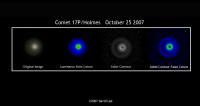 Comet
17/P Holmes: Luminance and Contour - Oct 25, 2007 - Image analysis
routines in AstroArt were used to enhance the original image of the comet.
False colour of the luminance made the halo of the comet head more
prominent. The contour filter along with false colour shows the
pseudo-nucleus more clearly It truly is an unusual comet.
David Lee Comet
17/P Holmes: Luminance and Contour - Oct 25, 2007 - Image analysis
routines in AstroArt were used to enhance the original image of the comet.
False colour of the luminance made the halo of the comet head more
prominent. The contour filter along with false colour shows the
pseudo-nucleus more clearly It truly is an unusual comet.
David Lee |
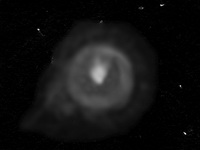 Comet
17/P Holmes - Oct 22, 2007 Comet
17/P Holmes - Oct 22, 2007This is a sketch that I did of this amazing comet as viewed through an f/5 635mm Newtonian reflector. Using a bino viewer with 23mm eyepieces for 138X magnification. The FOV is approx 0.4 of a degree. The structure to this comet is amazing. Bill Weir
|
|
This is one of my best piggyback results. The nebula is quite beautiful and has a lot of detail that can be teased out. I used a homemade microfocuser which helped in getting precise focus and took lots of frames. John McDonald
|
|
Location: DAO Centre of the Universe, Victoria, BC. Optics:
Equinox 80mm, f6.25, ED Refractor Mount: HEQ5 Camera: Nikon D50 Modified |
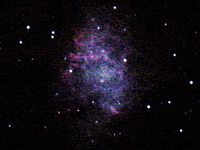 M1
Crab Nebula - Sept 9 & 10, 2007 M1
Crab Nebula - Sept 9 & 10, 2007The Crab Nebula has been on my list of objects to photograph for quite some time. Having recently acquired a Hutech modified dSLR finally gave me the gear I needed to successfully image this faint nebula - a remnant of the first supernova observed by astronomers on Earth in the year 1054. Joe Carr |
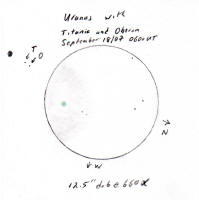 Bill
Weir observes
the moons of Uranus from Pearson College on Sept 17th! Bill
Weir observes
the moons of Uranus from Pearson College on Sept 17th!
On September 12th Alan Whitman put forth the challenge as to whether a moderate sized telescope would be able to see any of the Moons of Uranus. Seeing as he deemed a12.5� scope moderate in size a little voice in my head said, �sign me up�. Here is my tale. The night of Monday September 17th was so much fun. Bill Weir
|
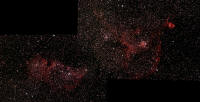 The
Heart and Soul Nebulae - Sept 8 & 10, 2007 - My first attempt at
creating a mosaic (merged manually using Photoshop). I wanted to image the
Soul emission nebula for some time but was having trouble locating and
framing it. I can see where the Heart nebula gets its name from. The bright
open cluster NGC 1027 is to the left of the nebula. Also close-by are the
following smaller open clusters: Tom 4, Mrk 6, Be 65, and Cz 13.
Charles Banville The
Heart and Soul Nebulae - Sept 8 & 10, 2007 - My first attempt at
creating a mosaic (merged manually using Photoshop). I wanted to image the
Soul emission nebula for some time but was having trouble locating and
framing it. I can see where the Heart nebula gets its name from. The bright
open cluster NGC 1027 is to the left of the nebula. Also close-by are the
following smaller open clusters: Tom 4, Mrk 6, Be 65, and Cz 13.
Charles Banville |
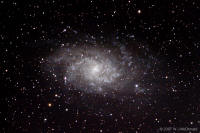 M33
- Triangulum Galaxy - Sept 2007 - from two sessions, one
at the
7th
Annual RASCALS Star Party 2007 at the Victoria Fish and Game site
and the other at the DAO. M33
- Triangulum Galaxy - Sept 2007 - from two sessions, one
at the
7th
Annual RASCALS Star Party 2007 at the Victoria Fish and Game site
and the other at the DAO.
|
| M31, M110, and M32- August 14 and 15, 2007 I took this image of the Andromeda galaxy over two nights this past week at the DAO. The weather on Monday and Tuesday nights turned out to be as good as it gets in Victoria. |
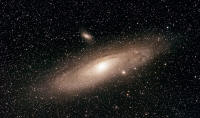 |
||
| NGC 884 and NGC 869- August 11, 2007 Image of the Perseus Double Cluster taken more than a week ago. East of it is the smaller open cluster NGC 957. I did get great views through Greg Higgs' 20" Dob while my camera was clicking away. The Veil and the Dumbbell looked like pictures. |
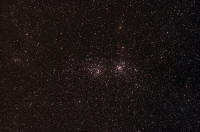 |
||
| M34 - A Tiny Cluster in Perseus - Aug 15/07 Here's
an object from a couple of nights ago when I was imaging the Milky Way. This
one had my head scratching for a few moments as I was trying to remember
which part of the sky it was. I knew the general direction so it didn't take
long for me to confirm a few stars around the cluster. It's been described
as an open cluster with a series of visual double stars. Another signature
feature is the series of three stars just above the cluster. |
 |
||
| Double Cluster & Muscle Man- Aug 14, 2007 Earlier this week I took advantage of the clear night skies and photographed along the Milky Way, specifically below Cassiopeia. It's a wonderful area of the sky as is the opposite side of the Milky Way where the Teapot is. I worked my way up from the OB-Association of stars near Mirfak to the Double Cluster. When I reviewed the images I noticed a curious asterism next to it. It looked oddly like a juggling stickman. A quick look at the Sky told me it wasn't a discovery ... at least in the true sense. The asterism is known as Stock 2 and is commonly called the Muscle Man. I do recall seeing it before in a refractor many years ago, I just didn't realize it was so close to the Double Cluster. If you have an eyepiece that gives you a 3 to 4 degree field of view you can frame it very nicely, the same field of view that would allow you to see the Double Cluster in one view. The top image highlights the Double Cluster & the Muscle Man asterism. |
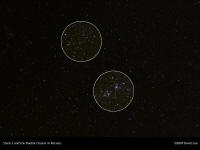 |
||
| Sadr region of Cygnus - Aug 13, 2007 My initial
testing of the Hutech enhanced Canon XTi dSLR is very encouraging. I imaged
the region surrounding Sadr in Cygnus The visibility of the
emission and dark nebulae surrounding Sadr is striking. Some of the objects in the 5� wide field of view (bottom photo) surrounding Sadr: : emission nebulae IC 1311 (above Sadr) and IC1318 (below Sadr), the Crescent Nebula (small bright red circle located about 1/2 way to the right of Sadr), M29 open cluster below IC 1318 as well as a second open cluster beside it named Berk 86, more prominent dark nebulae surrounding IC 1311 & 1318. Joe Carr |
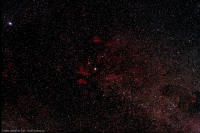 |
||
| Blue Snowball NGC 7662 - Aug 11, 2007 This is a picture of the Blue Snowball NGC 7662 located in Andromeda. I figured out that over 8 sec exposure time without drizzling mode active is not working really good. Next time I will try 15 sec exposure timeframe. Michel Michaud |
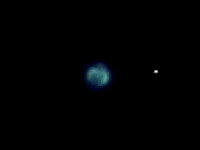 |
||
| Messier 81 and 82 - Aug 11, 2007 Last night I
redid my images of M81-82. I made more images, 60 instead of 45 and with
each being at 45 sec. instead of 30 sec. of exposure. Also, these images
were shot in RAW instead of JPG. I think the effort is much better than my
images of Sunday night. |
_small.jpg) |
||
| Cassiopeia rising over The Plaskett - Summer 2007 This is the result of merging two images. I shot the Plaskett Dome on July 26, 2007. The star trail was created by using images taken from Cattle Point on August 8, 2007. I took an azimuth reading during the shoot at the DAO and used it at Cattle Point in order to reproduce similar conditions. Setting up the altitude was more difficult since there is no scale on my Manfrotto mount. Charles Banville
|
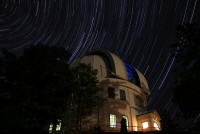 |
||
| M51 Whirpool Galaxy - Aug 6, 2007 I did this image in low resolution JPEG and not high resolution RAW. Also, I should have taken more images. Maybe this Saturday, if the weather is good and there are not to many meteors to disfigure my images, I will have another go. |
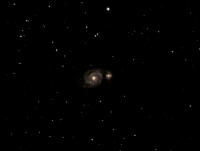 |
||
| NGC 7635, the Bubble Nebula and M52 globular cluster -
Aug 5/6, 2007 Another great night at the hill thanks to the weather gods who started to send clouds, then noticed us and took them away again. I tried imaging NGC 7635, the bubble Nebula for the first time and will likely have another go in the dark Saskatchewan skies. It is a beautiful object and would benefit from more exposure (see the incredible image of it in the last Sky News). Still, I am pleased with my first try and like the combination with M 52. John McDonald |
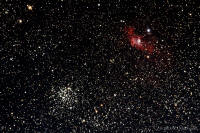 |
||
| IC 1396 - August 5, 2007 Good turn out at the DAO
last night. It was nice to see so many members out and about. Carrying on
with my study of dark nebulae, I pointed my telescope at IC 1396, a massive
nebula located in Cepheus. B160, B161, B162, B163, B365, B366, and B367
represent the most conspicuous dark nebulae in this image. |
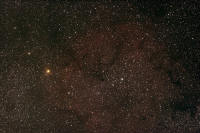 |
||
| IC5146, the Cocoon Nebula - Aug 4/5, 2007 Wonderful time at the hill last night with Joe Carr, Malcolm Scrimger, Guy Walton, Steve Pacholuk, Roland Honicke and Charles Banville. I imaged IC5146, the Cocoon Nebula for the first time. It is in an interesting setting with the dark nebula Barnard 168 surrounding it and trailing off to the west. I continue to be amazed at how many beautiful things there are in the sky. Thanks to Charles for being MIC. John McDonald |
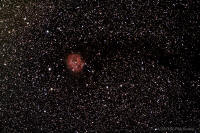 |
||
| M16 Eagle Nebula - Aug 4, 2007 Using my Canon 30D mounted prime focus on my Meade LX200R operating at f/10, I finally succeeded in imaging this object. 30 second exposures really didn't gather an adequate amount of photons for this object, so the resulting image could be improved upon. This is where a modified dSLR would really help, since the Ha emission reveals so much more detail for this strong emission lines produced by the Eagle Nebula. I'm pleased I managed to tease out as much detail from the clouds of gas (aka "Pillars of Creation") as show up in the resultant image, but further work on this object will have to wait until I acquire a modified dSLR. Joe Carr |
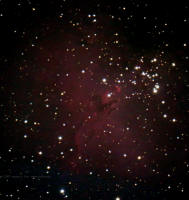 |
||
| NGC 7000 and IC 5067 - North America and Pelican Nebulae
- August 3, 2007 A portrait of the North America and Pelican Nebulae taken through some new glass of mine. Wanting something light and portable, I recently acquired a Borg 77mm telescope. I think this little scope will be a perfect match for my SkyMemo mount. |
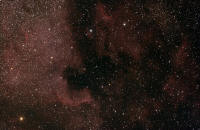 |
||
| M20, the Trifid Nebula - Aug 1, 2007 There was a short period between the time it got dark and the moon rise last evening and a few of us (Joe, Malcolm, Bruno and Charles) gathered in my back yard. I had a go at imaging the M20, the Trifid Nebula and the attached is the result. |
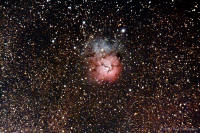 |
||
| Groombridge 34 - July 30, 2007 This is a picture of the star Groombridge 34. First I took this image for reference to calculate the proper motion of the star but the result is probably the best ever with my Measde DSI. |
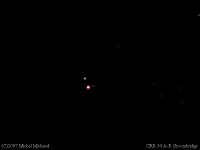 |
||
| Double Cluster - July 7, 2007 It's been a long time since I've observed from Cattle Point. Early in the evening the views of Venus and Jupiter were not stunning especially Venus that looked like it was on fire, alright it was near the horizon line. I pointed the Fuji S2 at a number of areas of the sky but the you know it doesn't get that dark at this time of the year. With the Moon coming up I had to decide on something to image. I settled on a Fall favourite the Double Cluster. It pays to stay up a little bit longer so you see what a preview of what's coming up in the following weeks. I had been playing around all evening with the balance of the GM8. I still haven't removed the backlash in the RA so I really have to concentrate on making sure the gears mesh. David Lee |
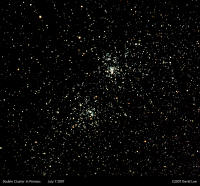 |
||
| M82 Cigar Galaxy - July 5, 2007 Last evening my main target was M82, the Cigar Galaxy. The attached image is my best effort to date, and shows quite a bit of detail and colour for this irregular galaxy. |
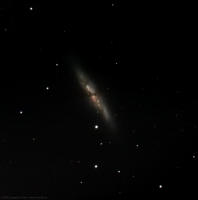 |
||
| The Snake Nebula - July 4, 2007 I framed part of the large Pipe Nebula (LDN 1773) in Ophiuchus from Cattle Point last night. I counted well over 20 catalogued dark nebulae in this image, the Snake Nebula taking centre stage. |
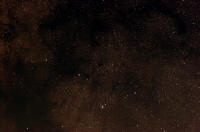 |
||
| Jupiter - July 4, 2007 at 11:18pm PDT Jupiter - July 3, 2007 at 11:34pm PDT These photos of Jupiter were taken from Observatory Hill. The seeing was superb for the first few hours after twilight, yielding quite a bit of detail and some wonderful colour. Two of the closest moons are also just visible near the left and right edges of the top-most frame, and the bottom frame shows two moons as well. . |
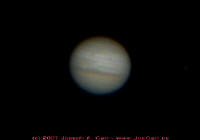 |
||
| Eastern & Western Veil Nebulae - July 3,4,5, 2007 I have been itching to try the veil with the modified Canon 350d (Rebel). It was a beautiful evening but not really a veil night given a moon that was not far past full but I had a go anyway and the attached is the result. It is not bad considering the sky glow and the fact that I could not take many frames before the moon got too high for imaging. At the hill again last night with Joe and Steve I opted to get more exposure of the veil. The weather was phenomenal - no wind and 22 degrees at 1:30am when the moon got up over the trees and we stopped. The attached is a combination of two nights imaging resulting in an hour and 41 minutes worth of light frames. I am pleased with the way it shows the rich star field as well as the nebula. There are enough bits of nebulosity showing to outline the overall shape of this huge supernova remnant. John McDonald |
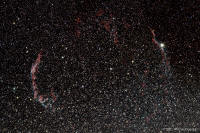 |
||
| M10 & M22 - July 3, 2007 This is my result using Registar stacking and combining22 images of M22. I am in a learning mode so any observations would be appreciated.
|
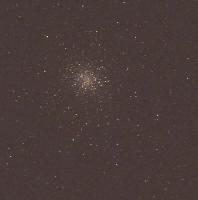
|
|